|
|
|
Sort Order |
|
|
|
Items / Page
|
|
|
|
|
|
|
| Srl | Item |
| 1 |
ID:
191165


|
|
|
|
|
| Summary/Abstract |
Auctions are currently the dominant and most rapidly expanding form of support for renewable energy project deployment, capturing the interests of policy-makers and academics alike. This article provides a systematic review of the relatively recent but already abundant literature on auctions for renewable energy and proposes a future research agenda on the topic. Major themes, gaps in knowledge, and trends in the literature are highlighted. More research efforts will be needed on the institutional capacity and arrangements, coordination between auctions and other procedures and appropriate inclusion of auctions in policy mixes. The trade-offs between different criteria should be the focus of more rigorous and quantitative marginal analysis, identifying the extent to which improving a given criterion worsens another. The existence, causes and consequences of underbidding, the implications of the just energy transition for the performance of auctions and auction design, the marginal impact of the level of design elements and the interactions between design element choices in “design element packages” merit more attention. There should be a greater focus on the micro-level in the assessment of the success of auctions and auction design. At a methodological level, assessments of auctions with case studies should coexist with more quantitative studies on the topic, using a wide range of methodologies. However, the transferability of lessons on the functioning of design elements across different contexts will be necessarily limited. Finally, a plea is made to national governments and international institutions to facilitate the access to auction data.
|
|
|
|
|
|
|
|
|
|
|
|
|
|
|
|
| 2 |
ID:
088055


|
|
|
|
|
| Publication |
2009.
|
| Summary/Abstract |
The European Commission has proposed a new Renewable Energy Directive, which includes flexibility provisions allowing the cost-effective attainment of the ambitious target for renewable energy of 20% of energy consumption, which has been set for the year 2020. One of the flexibility provisions currently being considered is to allow countries to reach their individual targets by buying their renewable electricity deployment deficit from other countries with a surplus (i.e., with a renewable electricity deployment above their targets). This trade is likely to take the form of an exchange in guarantees of origin (GOs). GOs are currently implemented in Member States to fulfil the Renewable Electricity Directive requirement that each country has a system that allows the tracing of the source of each kWh of renewable electricity and informs on this source. Although the recent and tiny literature on the analysis of GO trading has focused on trade between firms, the exchange of GOs between governments has not received a comparable attention. This paper analyses the advantages and drawbacks of a system of government trading of GOs with respect to company trading.
|
|
|
|
|
|
|
|
|
|
|
|
|
|
|
|
| 3 |
ID:
132678
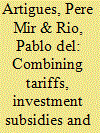

|
|
|
|
|
| Publication |
2014.
|
| Summary/Abstract |
Policy combinations and interactions have received a considerable attention in the climate and energy policy realm. However, virtually no attention has been paid to the analysis of the combination of different deployment instruments for the same renewable energy technology. This neglect is all the more striking given the existence in current policy practice of combinations of deployment instruments either across technologies or for the same technology, both in the EU and elsewhere. What renewable electricity support policies to use and, therefore, how to combine them in order to promote the deployment of renewable energy technologies cost-effectively is a main concern of governments. The aim of this paper is to provide insight on the cost-effectiveness of combinations of deployment instruments for the same technology. A financial model is developed for this purpose, whereby feed-in tariffs (FITs) are combined with investment subsidies and soft loans. The results show that the policy costs of combinations are the same as for the FITs-only option. Therefore, combining deployment instruments is not a cost-containment strategy. However, combinations may lead to different inter-temporal distributions of the same amount of policy costs and, thus, differently affect the social acceptability and political feasibility of renewable energy support.
|
|
|
|
|
|
|
|
|
|
|
|
|
|
|
|
| 4 |
ID:
112332


|
|
|
|
|
| Publication |
2012.
|
| Summary/Abstract |
In a recent article Mabee et al. [2012, Energy Policy 40 (1), 480-489] describe the German legislation to promote renewable electricity generation (Erneuerbare-Energien-Gesetz). The erroneous assumption that an annual degression of feed-in tariffs for any given power generating facility are stipulated in the law leads to a wrong calculation of net present values of the revenue stream. Reduction of feed-in tariff rates only holds for new additions. There is however one exception in offshore wind energy where the operator can opt for a degression. The implications of the newly introduced option are discussed in this comment.
|
|
|
|
|
|
|
|
|
|
|
|
|
|
|
|
| 5 |
ID:
111101


|
|
|
|
|
| Publication |
2012.
|
| Summary/Abstract |
The development of feed-in tariff (FIT) programs to support green electricity in Ontario (the Green Energy and Green Economy Act of 2009) and Germany (the Erneuerbare Energien-Gesetz of 2000) is compared. The two policies are highly comparable, offering similar rates for most renewable electricity technologies. Major differences between the policies include the level of differentiation found in the German policy, as well as the use of a price degression strategy for FIT rates in Germany compared to an escalation strategy in Ontario. The German renewable electricity portfolio is relatively balanced, compared to Ontario where wind power dominates the portfolio. At the federal level, Canada does not yet have a policy similar to the European Directive on Renewable Energy, and this lack may impact decisions taken by manufacturers of renewable technologies who consider establishing operations in the province. Ontario's Green Energy and Green Economy Act could be benefit from lessons in the German system, especially with regard to degression of feed-in tariff rates over time, which could significantly reduce payments to producers over the course of a contract, and in turn encourage greater competitiveness among renewable power providers in the future.
|
|
|
|
|
|
|
|
|
|
|
|
|
|
|
|
| 6 |
ID:
113449


|
|
|
|
|
| Publication |
2012.
|
| Summary/Abstract |
Green marketing research has traditionally analysed the effect of attitudes and norms on purchase intentions and behaviours. While we are aware of research examining attitudes and behaviours towards green tangible products (e.g., Paladino, 2005), there is no understanding regarding how these factors apply to intangible renewable power services. Similarly, branding and its effects are scant in a contemporary green marketing context. Of this research, most has evaluated the product and not service brands. Some have researched the extent of green branding and its effects on attitudes (e.g., Hartman et al., 2005). Despite this, research evaluating the role of renewable electricity retailer brands and their characteristics is limited. This study works towards understanding this and seeks to bind the existing branding, services marketing and consumer behaviour literatures to understand the motivators behind renewable electricity purchase in Australia.
With the introduction of contestable customers and the increase in importance of renewable energy around the world, it is imperative that renewable electricity retailers attract consumer interest and attain their consideration. Using focus group research and in-depth interviews from consumers in Australia, this paper analyses the strategic options available to the power provider to increase their appeal to the consumer. Theoretical and managerial implications are reviewed.
|
|
|
|
|
|
|
|
|
|
|
|
|
|
|
|
| 7 |
ID:
137732


|
|
|
|
|
| Summary/Abstract |
A higher percentage of energy from renewable resources is an important goal on many environmental policy agendas. Yet, the demand for renewable electricity in liberalized markets has developed much more slowly than the demand for other green products. To date, research has mainly examined the willingness to pay for renewable electricity, but limited research has been conducted on the motivations behind it. The concept of identity signaling has proven to play a significant role in consumer behavior for green products. However, (renewable) electricity in the Swedish residential market typically lacks two important drivers for identity signaling: visibility and product involvement. A consumer choice simulation among 434 Swedish households compared consumer choices for renewable electricity contracts. The results show a positive effect of identity signaling on the demand for renewable electricity and yield suggestions for increasing the share of renewable electricity without market distorting measures. This leads to implications for policymakers, electricity suppliers and researchers.
|
|
|
|
|
|
|
|
|
|
|
|
|
|
|
|
| 8 |
ID:
179703
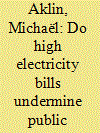

|
|
|
|
|
| Summary/Abstract |
The clean energy transition has long been framed in terms of its technological and economic feasibility. An increasingly salient constraint lies in its political feasibility. The transition requires vigorous public support to be completed. Yet increased consumer costs associated with the deployment of renewable electricity could make voters - and, by extension, governments - less supportive of it. As a result, overly aggressive government support for renewables could lead to its own downfall. To examine this threat, I document two stylized facts. First, the expansion of renewable electricity capacity has been followed by an increase in household electricity bills, and this has mostly happened because of energy-specific taxes. An increase of renewable electricity capacity by one within-country standard deviation raises a typical household's bill by €5.7 per MWh (95% CI: [3, 8.3]), most of which comes from an increase in non-VAT taxes (+€3.8/MWh [2.6; 5.1]). Second, these taxes have hurt popular support for aggressive renewable energy policy. An increase of non-VAT taxes by one standard deviation increases the share of people who find renewable energy too ambitious by 0.7 percentage points (95% CI: [0.1; 1.3]). Climbing costs could therefore undermine further political support toward renewable electricity deployment and threaten its contribution to greenhouse gas reductions.
|
|
|
|
|
|
|
|
|
|
|
|
|
|
|
|
| 9 |
ID:
125792


|
|
|
|
|
| Publication |
2013.
|
| Summary/Abstract |
Using the Poisson pseudo-maximum likelihood estimation technique, this paper evaluates the effects of renewable electricity policies on renewable electricity generation using a large panel dataset that covers 122 countries over the period of 1980-2010. The results suggest that renewable electricity policies play a crucial role in promoting renewable electricity generation, but their effectiveness is subject to diminishing returns as the number of policies increases. There is also evidence that the effects of renewable electricity policies are more pronounced before 1996 as well as in developed and emerging market countries, and the negative policy interaction effect fades with the stage of economic development. Lastly, policy effectiveness varies by the type of renewable electricity policy and energy source. Only investment incentives and feed-in tariffs are found to be effective in promoting the development of all types of renewable energy sources for electricity considered in this paper.
|
|
|
|
|
|
|
|
|
|
|
|
|
|
|
|
| 10 |
ID:
163533
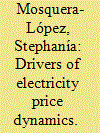

|
|
|
|
|
| Summary/Abstract |
Against the backdrop of numerous evidence that variable renewable generation decreases electricity prices and increases price volatility, this paper assesses the drivers of electricity prices in spot and futures markets, focusing on the German electricity markets. We take into account nonlinearities in electricity prices by means of structural breaks and threshold regressions. We find that short-run and medium/long-run price drivers differ and, more importantly, that they vary over time. In the case of the spot market, the determinants of prices are renewable infeed and electricity demand, while in the futures market the main drivers are natural gas, coal and carbon prices. Our results give relevant insights for market participants who seek to optimize procurement/selling strategies in the spot market, and use the futures market to hedge against spot price volatility, which has increased due to a higher renewable generation.
|
|
|
|
|
|
|
|
|
|
|
|
|
|
|
|
| 11 |
ID:
069819


|
|
|
| 12 |
ID:
107491


|
|
|
|
|
| Publication |
2011.
|
| Summary/Abstract |
Renewable Portfolio Standards (RPSs) are renewable electricity (RES-E) subsidy mechanisms in which governments mandate how much RES-E should be generated and markets determine the cost of the subsidy needed to generate the RES-E. Two modifications of the RPS that can help support high-cost types of RES-E are banding, where governments mandate higher multiples of RPS tradable certificates for high-cost types of RES-E, and carve-outs, where governments prescribe parts of a RPS target that can be met only by a particular type, or types, of RES-E.
This paper analyses the design and generation performance of banding, as used in the UK, with some reference to Italy; and carve-outs, as used in the USA. To date, there is insufficient experience of either device to reach firm conclusions about their generation effectiveness. However, there is early, tentative evidence that banding is successful at supporting high-cost types of RES-E in the UK. Carve-outs are not being fully exploited in US states that use a RPS mechanism, and Italy is using banding in a fairly insignificant way. Though both devices have different design strengths and weaknesses, and either could be adapted to specific RPS markets, banding is probably the better device for supporting high-cost RES-E.
|
|
|
|
|
|
|
|
|
|
|
|
|
|
|
|
| 13 |
ID:
133031


|
|
|
|
|
| Publication |
2014.
|
| Summary/Abstract |
China has adopted targets for developing renewable electricity that would require expansion on an unprecedented scale. During the period from 2010 to 2020, we find that current renewable electricity targets result in significant additional renewable energy installation and a reduction in cumulative CO2 emissions of 1.8% relative to a No Policy baseline. After 2020, the role of renewables is sensitive to both economic growth and technology cost assumptions. Importantly, we find that the CO2 emissions reductions due to increased renewables are offset in each year by emissions increases in non-covered sectors through 2050. We consider sensitivity to renewable electricity cost after 2020 and find that if cost falls due to policy or other reasons, renewable electricity share increases and results in slightly higher economic growth through 2050. However, regardless of the cost assumption, projected CO2 emissions reductions are very modest under a policy that only targets the supply side in the electricity sector. A policy approach that covers all sectors and allows flexibility to reduce CO2 at lowest cost - such as an emissions trading system - will prevent this emissions leakage and ensure targeted reductions in CO2 emissions are achieved over the long term.
|
|
|
|
|
|
|
|
|
|
|
|
|
|
|
|
| 14 |
ID:
103477


|
|
|
|
|
| Publication |
2011.
|
| Summary/Abstract |
The Western Renewable Energy Zone (WREZ) initiative brings together a diverse set of voices to develop data, tools, and a unique forum for coordinating transmission expansion in the Western Interconnection. In this paper we use a new tool developed in the WREZ initiative to evaluate possible renewable resource selection and transmission expansion decisions. We evaluate these decisions under a number of alternative future scenarios centered on meeting 33% of the annual load in the Western Interconnection with new renewable resources located within WREZ-identified resource hubs. Our analysis finds that wind energy is the largest source of renewable energy procured to meet the 33% RE target across nearly all scenarios analyzed (38-65%). Solar energy is almost always the second largest source (14-41%). We find several load zones where wind energy is the least cost resource under a wide range of sensitivity scenarios. Load zones in the Southwest, on the other hand, are found to switch between wind and solar, and therefore to vary transmission expansion decisions, depending on uncertainties and policies that affect the relative economics of each renewable option. Further, we find that even with total transmission expenditures of $17-34 billion these costs still represent just 10-19% of the total delivered cost of renewable energy.
|
|
|
|
|
|
|
|
|
|
|
|
|
|
|
|
| 15 |
ID:
186486
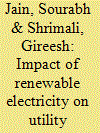

|
|
|
|
|
| Summary/Abstract |
Declining levelized costs of renewable energy have become a driving force in supporting renewable energy in India; the levelized cost of wind and solar has plummeted to between 3.3¢/kWh and 4¢/kWh. However, limited research exists on the impacts of renewables on the finances of Indian distribution utilities. The present study examines the financial impact of incremental penetration of the hydro, solar, and wind alternative in the generation mix of the distribution company of the Indian state of Madhya Pradesh. Using real-time 15-min interval data and a merit-order-dispatch model, the study quantifies the merit-order-effect and assess the potential savings from renewables. The results indicate that depending upon the penetration level under demand growth cases, renewable integration could lower the power purchase cost of Indian utilities by up to 11%. Wind produces most savings between 0.11¢/kWh and 2.71¢/kWh followed by solar −0.17¢/kWh and 2.56¢/kWh and hydro −0.32¢/kWh and 2.05¢/kWh. The savings will increase with rising electricity demand and plummeting costs of renewables. Integrating moderate levels of renewables no longer presents economic-environment trade-offs and can simultaneously meet multiple policy goals of energy affordability and environmental sustainability.
|
|
|
|
|
|
|
|
|
|
|
|
|
|
|
|
| 16 |
ID:
176830
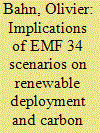

|
|
|
|
|
| Summary/Abstract |
This paper proposes a detailed analysis of the evolution of Canadian energy systems under some selected EMF (Energy Modeling Forum) 34 scenarios. Our analysis is based on NATEM, an energy model that follows the TIMES approach of the International Energy Agency to represent in detail the energy sector of each of the 13 Canadian provinces and territories. NATEM shows that imposing different renewable penetration constraints for electricity generation has limited impacts outside the electricity sector. In particular, greenhouse gas (GHG) emissions continue to increase over time. Conversely, the imposition of a carbon tax has broader impacts on Canadian energy systems and on GHG emissions that are almost stabilized. However, the level of the carbon tax envisions by the EMF 34 study (increasing to a maximum level of $130 per tonne by 2050) is not high enough, in a Canadian context, to trigger a decrease of GHG emissions over time as mandated by Canadian climate policies.
|
|
|
|
|
|
|
|
|
|
|
|
|
|
|
|
| 17 |
ID:
125415


|
|
|
|
|
| Publication |
2013.
|
| Summary/Abstract |
Least cost options are presented for supplying the Australian National Electricity Market (NEM) with 100% renewable electricity using wind, photovoltaics, concentrating solar thermal (CST) with storage, hydroelectricity and biofuelled gas turbines. We use a genetic algorithm and an existing simulation tool to identify the lowest cost (investment and operating) scenarios of renewable technologies and locations for NEM regional hourly demand and observed weather in 2010 using projected technology costs for 2030. These scenarios maintain the NEM reliability standard, limit hydroelectricity generation to available rainfall, and limit bioenergy consumption. The lowest cost scenarios are dominated by wind power, with smaller contributions from photovoltaics and dispatchable generation: CST, hydro and gas turbines. The annual cost of a simplified transmission network to balance supply and demand across NEM regions is a small proportion of the annual cost of the generating system. Annual costs are compared with a scenario where fossil fuelled power stations in the NEM today are replaced with modern fossil substitutes at projected 2030 costs, and a carbon price is paid on all emissions. At moderate carbon prices, which appear required to address climate change, 100% renewable electricity would be cheaper on an annual basis than the replacement scenario.
|
|
|
|
|
|
|
|
|
|
|
|
|
|
|
|
| 18 |
ID:
176734


|
|
|
|
|
| Summary/Abstract |
Renewable energy auctions have been lauded for bringing about price reductions. However, the methods applied in investigating such impacts have so far been inadequate and often do not allow conclusions to be drawn as to whether observed price reductions were caused by auctions or by other factors. We have analysed the outcomes of the first onshore wind auctions in Germany held in 2017 and 2018, taking into account the site-specific wind conditions and realisation deadlines of the successfully bid projects. Our results show that after a temporary reduction, prices exceeded both the initial levels and the transitional feed-in tariff. A lack of public acceptance and numerous legal complaints against building permissions have contributed to bids falling below auction volumes in 2018. These results are discussed against the backdrop of the functional and structural promises associated with the introduction of auctions, including reduced remuneration levels, better control of the pace of the capacity expansion and who is able to influence the setting of the remuneration levels.
|
|
|
|
|
|
|
|
|
|
|
|
|
|
|
|
| 19 |
ID:
175264
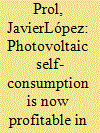

|
|
|
|
|
| Summary/Abstract |
Whereas Spain used to have one of the most restrictive photovoltaic self-consumption (PVSC) regulations in the world, the new regulation (RD-L 15/2018 & RD 244/2019) improves the economic conditions of PVSC systems, simplifies administrative procedures and allows shared self-consumption. We analyze the impact of the new PVSC regulation on residential, commercial and industrial prosumers’ profitability (internal rate of return). We provide a wide range of results that allow us to explore future profitability depending on the evolution of installation costs, the opportunities of shared self-consumption or storage, and even the potential emergence of new business models. We find that all segments obtain now positive profitability in average conditions. Whereas the residential segment has the lowest profitability level, it has the highest potential by decreasing installation costs and increasing the share of self-consumption, given its higher retail prices. Finally, we identify potential new business models by exploiting the prices and costs differentials across segments and maximizing the share of self-consumed electricity. PVSC systems with industrial costs exploiting residential markets could achieve 35% profitability by reaching 75% self-consumption, and even higher than 40% when self-consumption exceeds 85%.
|
|
|
|
|
|
|
|
|
|
|
|
|
|
|
|
| 20 |
ID:
126843
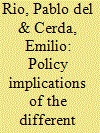

|
|
|
|
|
| Publication |
2014.
|
| Summary/Abstract |
The cost-effectiveness of support for renewable electricity is a main criterion to assess the success of policy instruments, together with effectiveness. The costs of support are also a source of significant concern for governments all over the world. However, significant confusion exists in the literature on the cost-effectiveness of public support for renewable electricity. While some authors define the concept of cost-effectiveness as that which complies with the equimarginality principle, many others, including documents from relevant organisations (European Commission, International Energy Agency, Intergovernmental Panel on Climate Change) define it as "the lowest costs of support", generally equating it with the minimisation of consumer costs. The aim of this paper is to clarify the differences between both approaches and their policy implications regarding the choice of instruments and design elements. It is shown that they partly overlap and that their policy implications clearly differ, leading to very different policy prescriptions. While the former favours technology neutral instruments and design elements, the "minimisation of consumer costs" approach favours instruments and design elements which adjust support levels to the costs of the technologies.
|
|
|
|
|
|
|
|
|
|
|
|
|
|
|
|
|
|
|
|
|